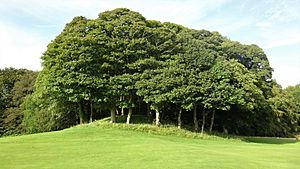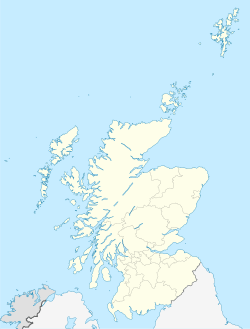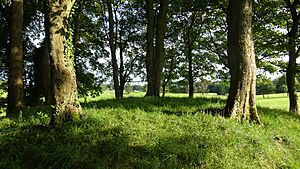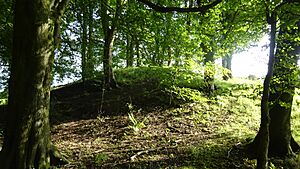Castle Hill, Caprington facts for kids

Castle Hill from the south
|
|
| Alternative name | Castle Motte, Caprington |
|---|---|
| Location | East Ayrshire, Scotland |
| Coordinates | 55°35′26″N 4°30′51″W / 55.590625°N 4.5140785°W |
| Type | Moot hill / Motte & Bailey |
| Length | 55ft |
| Width | 30ft |
| History | |
| Material | Earth |
| Periods | Medieval |
| Site notes | |
| Excavation dates | None |
| Archaeologists | John Smith |
| Condition | Golf couse damage |
| Ownership | Private |
| Public access | Yes |
| Website | [1] |
The Castle Hill is a noticeable wooded mound found near Damhead House. It is part of the Caprington Estate in Riccarton, East Ayrshire, Scotland. This mound might have been used for many things over time. It could have been a fort, a special meeting place called a moot hill, or just a cool part of the estate's landscape.
History of Castle Hill
Castle Hill is also known as the Castle Motte. A "motte" is a type of mound that was often part of an old castle. This mound is now covered with trees. It sticks out like a raised bump from a higher ridge. The very top of the mound is flat and about 5 meters (16 feet) wide.
There are no signs left of a ditch or moat that might have once separated it from the ridge. The mound might be partly man-made. Because it has a flat top, it could have been a motte or a "moot hill" for the local area. A path used to lead to the top, and there was even a bench there.
What is a Moot Hill?
Castle Hill was planted with trees in the 1800s, as old maps show. Before that, it was a very clear feature in the landscape. This suggests it was once a moot, court, or justice hill. These were places where important meetings were held. Decisions were made, and justice was carried out. Sometimes, a "gallow hill" was nearby, where punishments happened. A "dule tree" might have stood there too.
Castle Hill is located within the old Barony of Caprington. A "barony" was a large area of land controlled by a lord. This barony was created by Mary Queen of Scots in 1564. Its main center, or "caput," was at the nearby Caprington Castle. Some old records of the decisions made by the Caprington Barony Court are kept in Edinburgh. There is also a pond nearby, but it might have been an old quarry that filled with water.
What Remains Today?
It's possible that a wooden building once stood on Castle Hill. However, there are no signs of stone foundations or walls on the mound today. Any ditch or moat that was once there might have disappeared over time. This could be due to natural soil movement. Also, work done by the estate and the golf course, like planting hedges, might have changed the area.
Sometimes, people would take stones from old, abandoned buildings to use for new construction. This might have happened here, with stones being used for nearby stone walls or houses. A well-made track or lane runs from Damhead House. It passes the bottom of Castle Hill before joining the road to Caprington Castle. This road is near the estate's bridge over the River Irvine.




